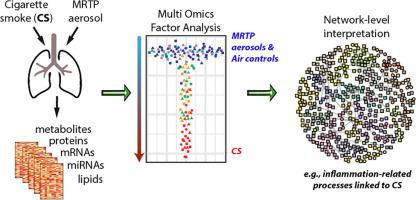Computational and Structural Biotechnology Journal ( IF 4.4 ) Pub Date : 2020-04-25 , DOI: 10.1016/j.csbj.2020.04.011 Bjoern Titz 1 , Justyna Szostak 1 , Alain Sewer 1 , Blaine Phillips 2 , Catherine Nury 1 , Thomas Schneider 1 , Sophie Dijon 1 , Oksana Lavrynenko 1 , Ashraf Elamin 1 , Emmanuel Guedj 1 , Ee Tsin Wong 2 , Stefan Lebrun 1 , Grégory Vuillaume 1 , Athanasios Kondylis 1 , Sylvain Gubian 1 , Stephane Cano 1 , Patrice Leroy 1 , Brian Keppler 3 , Nikolai V Ivanov 1 , Patrick Vanscheeuwijck 1 , Florian Martin 1 , Manuel C Peitsch 1 , Julia Hoeng 1

|
Cigarette smoke (CS) causes adverse health effects and, for smoker who do not quit, modified risk tobacco products (MRTPs) can be an alternative to reduce the risk of developing smoking-related diseases. Standard toxicological endpoints can lack sensitivity, with systems toxicology approaches yielding broader insights into toxicological mechanisms. In a 6-month systems toxicology study on ApoE−/− mice, we conducted an integrative multi-omics analysis to assess the effects of aerosols from the Carbon Heated Tobacco Product (CHTP) 1.2 and Tobacco Heating System (THS) 2.2—a potential and a candidate MRTP based on the heat-not-burn (HnB) principle—compared with CS at matched nicotine concentrations. Molecular exposure effects in the lungs were measured by mRNA/microRNA transcriptomics, proteomics, metabolomics, and lipidomics. Integrative data analysis included Multi-Omics Factor Analysis and multi-modality functional network interpretation. Across all five data modalities, CS exposure was associated with an increased inflammatory and oxidative stress response, and lipid/surfactant alterations. Upon HnB aerosol exposure these effects were much more limited or absent, with reversal of CS-induced effects upon cessation and switching to CHTP 1.2. Functional network analysis revealed CS-induced complex immunoregulatory interactions across the investigated molecular layers (e.g., itaconate, quinolinate, and miR-146) and highlighted the engagement of the heme–Hmox–bilirubin oxidative stress axis by CS. This work exemplifies how multi-omics approaches can be leveraged within systems toxicology studies and the generated multi-omics data set can facilitate the development of analysis methods and can yield further insights into the effects of toxicological exposures on the lung of mice.
中文翻译:

小鼠肺部多组学系统毒理学研究,评估两种不燃烧热的烟草制品和香烟烟雾中的气溶胶的影响。
香烟烟雾(CS)会对健康造成不利影响,对于不戒烟的吸烟者,改良风险烟草产品(MRTP)可以作为降低罹患与吸烟有关疾病的风险的替代方法。标准毒理学终点指标可能缺乏敏感性,系统毒理学方法可为毒理学机理提供更广泛的见识。在为期6个月的系统中,有关ApoE的毒理学研究-/-小鼠,我们进行了综合多组学分析,以评估碳加热烟草制品(CHTP)1.2和烟草加热系统(THS)2.2产生的气雾剂的影响-基于不燃烧的潜在潜力和候选MRTP( HnB)原理-与匹配烟碱浓度的CS相比。通过mRNA / microRNA转录组学,蛋白质组学,代谢组学和脂质组学来测量肺中的分子暴露效应。集成的数据分析包括多组学因子分析和多模式功能网络解释。在所有五个数据模式中,CS暴露与炎症和氧化应激反应增加以及脂质/表面活性剂改变有关。暴露于HnB气雾剂后,这些作用更为有限或不存在,CS诱导的作用在停止并转为CHTP 1.2时会逆转。功能网络分析揭示了CS诱导的跨研究分子层(例如衣康酸酯,喹啉酸酯和miR-146)的复杂免疫调节相互作用,并突出了CS对血红素-Hmox-胆红素氧化应激轴的参与。这项工作例证了如何在系统毒理学研究中利用多组学方法,并且生成的多组学数据集可以促进分析方法的发展,并且可以进一步了解毒理学暴露对小鼠肺部的影响。











































 京公网安备 11010802027423号
京公网安备 11010802027423号